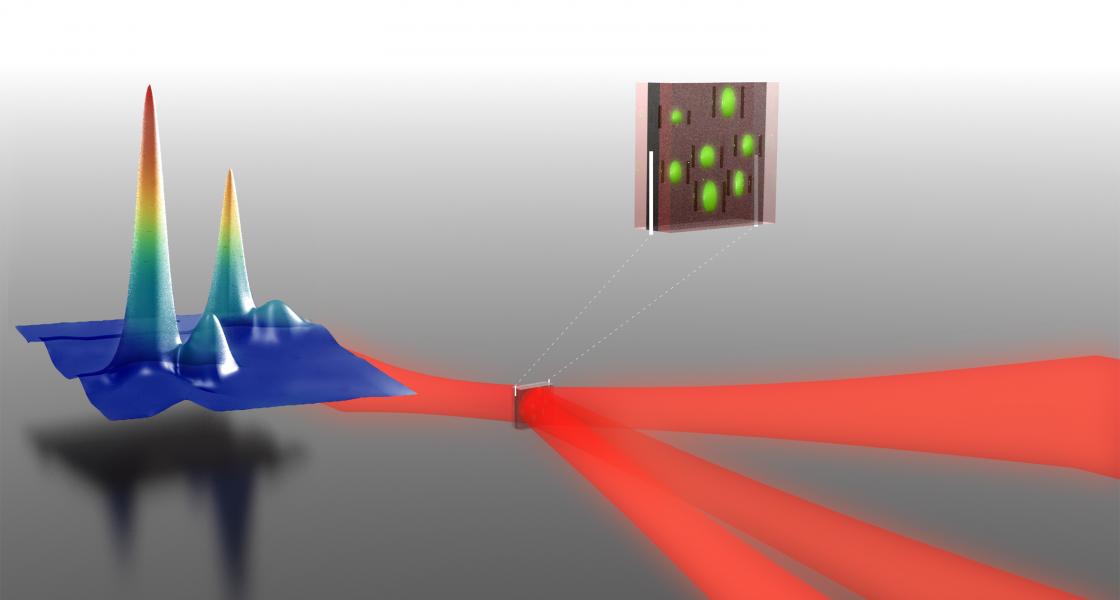The semiconductor gallium arsenide (GaAs) is used to make tiny structures in electronic devices such as integrated circuits, light-emitting diodes, laser diodes, and solar cells that directly convert light into electrical energy. Because of GaAs’s importance to modern electronics, the Cundiff group seeks to understand the fundamental physics of its light-matter interactions on atomic and electronic levels. Such an understanding requires the ability to “look” inside tiny boxes of GaAs (called quantum dots) with a series of laser pulses and correctly interpret the pattern of frequencies produced by the interaction of laser light with particles in the boxes. However, opening up these quantum “chambers of secrets” is a major challenge.
Fortunately, peering into quantum dots is the perfect job for the JILA MONSTR! The MONSTR is a precision optical instrument containing three cascaded and folded interferometers that split incoming laser pulses into four identical pulses. The sequence and timing of three of the pulses can be controlled to probe the GaAs quantum dots. The process is akin to striking a bell with a hammer three times: The first strike makes the bell vibrate. The second creates an interference pattern in the original vibration, enhancing some frequencies and damping out others. The third interacts with the remaining frequencies and the resulting ring-tone pattern contains information about the dynamics of the bell.
Similarly, the signals produced by interactions with a series of laser pulses reveal information about the dynamics of the strange world inside the GaAs quantum dots. When particles there interact with one or more pulses of laser light, they radiate light of different colors (frequencies). Researchers use a spectrometer and computer to convert these signals into multidimensional frequency spectra that make it easier for them to look for evidence of particle interactions.
Recently a team led by graduate student Galan Moody used the MONSTR to not only learn more about GaAs quantum dots, but also the interactions of particles inside the dots with the GaAs quantum well that surrounds them. The experimenters used samples arranged like Oreo™ cookies: The cookies correspond to the barriers of aluminum gallium arsenide (AlGaAs) that surround the GaAs on the sample wafer. The filling corresponds to a two-dimensional quantum well, and lumpy “islands” in the filling correspond to the zero-dimensional GaAs quantum dots. Inside both quantum dots and the quantum well, the laws of quantum mechanics determine behavior of electrons.
Gaining a better understanding of how those laws affect the behavior of particles in the quantum dots was one goal of Moody’s experiments. Moody was assisted by research associates Mark Siemens (now at the University of Denver), Alan Bristow (now at West Virginia University), Xingcan Dai (now at Tsinghua University in China), and Denis Karaiskaj (now at the University of South Florida); researchers from the Naval Research Laboratory, and Fellow Steve Cundiff.
The researchers studied excitons both inside the quantum dots and in the surrounding quantum well. An exciton is an atomlike particle consisting of a free electron bound to the positively charged hole that an electron leaves behind when it is excited in a semiconductor. The observed excitons were not as strongly held within the quantum dots as had been predicted. They existed in both bright and dark states and could switch back and forth from one state to the other.
If excitons formed inside a quantum dot, they tended to stay there rather than move into the quantum well. There appeared to be stronger interactions between excitons in quantum dots and the quantum well at lower temperatures. However, at higher temperatures, interactions between the excitons and the vibrating GaAs crystal structure caused the excitons to actually move between the quantum dots and the quantum well.
The researchers studied the behavior of excitons in superpositions of their ground and excited energy states. Such superpositions appear only in the quantum world. They occur when one or more quantized particles (which exist as waves) completely overlap. Over time, the researchers observed that exciton superpositions in the GaAs quantum dots gradually decay back to their ground states. The decay rate was influenced by interactions between the excitons and vibrations in the GaAs crystal structure.
One of the more interesting observations was that sometimes two excitons inside the same quantum dot would hook up to form moleculelike biexcitons. The formation of biexcitons was more likely to occur in smaller quantum dots because the strength of exciton-exciton interactions increases with decreasing quantum-dot size.
The amount of information about GaAs quantum dots garnered by Moody and his colleagues with the JILA MONSTR caught the attention of the Physical Review B editors, who picked their journal article about this topic as an “Editor’s Suggestion” in the March 23, 2011 issue.




